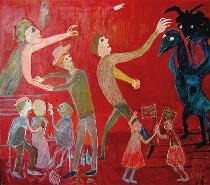The work at Fleisher/Ollman, which is up through August, is a mix of outsider and insider, young and old, and it’s hard to say where the twain don’t meet, because meet they do in lots of places.
For insider and outsider, I’ve got TC Campuzano who borrows outsider words stacked and compressed into a crazyquilt pattern, revealing a slice of subculture. My favorites were “Brix Smith Reveals All” and “California.” In Blix, a ’60s hippie tells some tale of partying that evokes that era, the words in a figure-ground struggle with yellow horizontals serving as places to rest the eye. In Cali, laid-back beach bums issue vacuous statements about how they spend their free time. The words are scrawled in the strata of a stack of colors that evoke beach and sky (top, “Important Communication,” the tale of a believer’s encounter with an alien and what the alien had to say).
For the mix of young and old, I’ve got Ray Yoshida on my mind, his imagery cut out of old comics and arranged to float in a rather haphazard grid on a plain white ground. Yoshida is no spring chicken, an emeritus faculty member from the Art Institute of Chicago, yet his work looks like it came from one of the young pop and skate-culture artists who worship old comic genres. My favorite piece was called “mmmm …” and it was the hair-dos adrift from everything but random bits of architecture or curtain selected from behind.
 Other show highlights included a Don Colley tile. Colley’s work was one of the high points in the “Say Something: The Art of Politics” show at the Painted Bride (see post) last November.
Other show highlights included a Don Colley tile. Colley’s work was one of the high points in the “Say Something: The Art of Politics” show at the Painted Bride (see post) last November.
Primitive work of note included self-taught Jon Serl’s “Capturing the School Mascot” (left), an energetic oil on canvas that has a crayon-y look that creates an epic scene, and Chuck Connely’s “Cathedral #16,” a dazzling color-and-pattern depiction of a church.
Oh, and I don’t want to leave out Bruce Pollock, whose career of seeking satori on canvas is still going strong. Of the oils, “Reds” enhanced the coliding spheres of the Pollock cosmos with colliding reds, and intense but beautifully composed piece that orbited from space to atomic structures and back again. The circles in his drawing “Net 1” looked like airy ringlets of hair that ultimately tangle toward a dense focal point where nature and space collide (right, “Net 1,” ink and graphite on paper).
Others in the show include Bill Traylor, SL Jones, Howard Finster, William Edmondson, Davis Brown, William Pym, David Smith, Sean Cavana and Edgar Tolson.
The biggest anomoly in the show was a collection of prison mug shots from the Fulton County Prison Farm in Georgia, c. 1940-1960. I guess I don’t think this is art, but it’s an artifact and somewhat interesting for the array of humanity and how people face down the culture of the prison system. I also like the hints of fashion from a time past.









